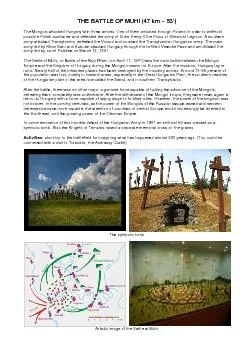

53 The Mongols attacked Hungary with three armies One of them attacked through Poland in order to withhold possible Polish auxiliaries and defeated the army of Duke Henry II the Pious of Sil ID: 840434
Download Pdf The PPT/PDF document "THE BATTLE OF MUHI 47 km" is the property of its rightful owner. Permission is granted to download and print the materials on this web site for personal, non-commercial use only, and to display it on your personal computer provided you do not modify the materials and that you retain all copyright notices contained in the materials. By downloading content from our website, you accept the terms of this agreement.
1 THE BATTLE OF MUHI (47 km – 53’)
THE BATTLE OF MUHI (47 km – 53’) The Mongols attacked Hungary with three armies. One of them attacked through Poland in order to withhold possible Polish auxiliaries and defeated the army of Duke Henry II the Pious of Silesia at Legnica. A southern army a ttacked Transylvania, defeated the Voivod and crushed the Transylvanian Hungarian army. The main army led by Khan Batu and Subutai attacked Hungary through the fortified Verecke Pass and annihilated the army led by count Palatine on March 12, 1241. The Ba ttle of Muhi, or Battle of the Sajó River, (on April 11, 1241) was the main battle between the Mongol Empire and the Kingdom of Hungary during the Mongol invasion of Europe. After the invasion, Hungary lay in ruins. Nearly half of the inhabited places had been destroyed by the invading armies. Around 15 - 25 percent of the population was lost, mostly in lowland areas, especially in the Great Hungarian Plain, the southern reaches of the Hungarian plain in the area now called the Banat, and in southern Transylv ania. After the battle, there was no other major organized force capable of halting the advance of the Mongols; defeating them completely was unthinkable. After the withdrawal of the Mongol troops, they were never again to return to Hungary with a force c apable of laying siege to fortified cities. However, the power of the kingdom was not broken. In the coming centuries, as the power of the Mongols of the Russian steppe waned and western defenses became more capable, th
2 e attention of countries of central E ur
e attention of countries of central E urope would increasingly be directed to the Southeast, and the growing power of the Ottoman Empire. In commemoration of this horrible defeat of the Hungarian Army in 1991 an artificial hill was created as a symbolic tomb. Also the Knights of Temples raise d a separate memorial cross on the graves. Activities: short trip to the battlefield for imagining what has happened almost 800 years ago. (Trip could be connected with a visit to Tiszadob, the Andrassy Castle) The symbolic tomb Artistic image of the Battle at Muhi TISZADOB (110 km – 1h 25’) The Andrássy Castle was probably built between 1880 - 1885 according to plans of Ignatius Alpár. The neo - romantic, built with many towers - 52, a large building block, imitating the castles of Loire Valley. Th e of panel paintings of the castle, which is 9 times 4.5 meters, is the work of the well - known modern art painter Péli Thomas, a Gypsy painter. The Foreign Minister Gyula Andrassy let build the castle along the lines of the French castles, and he also es tablished the English garden behind the castle, which is still a well - kept park. The park is the venue each year in early August of the Piano Festival in the East. The concert is featuring world - renowned artists. The Castle has recently been renovated wit h financial contribution from the European Union. It will be open to public in the near future. The park and it’s surrounding is already opened to public